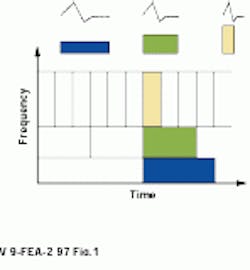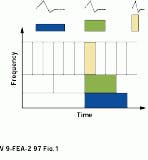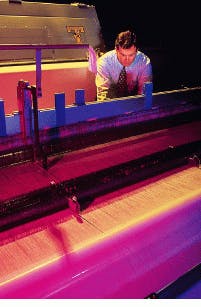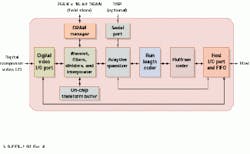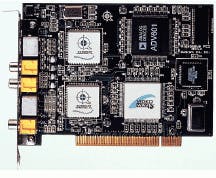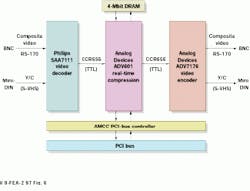System developers adopt wavelet techniques for image compression
System developers adopt wavelet techniques for image compression
By Richard Parker, Contributing Editor
Alongtime process tool of mathematicians and scientists, wavelet compression is now gaining popularity in digital video and image processing as a result of its implementation in low-cost silicon integrated circuits (ICs) and the wide availability of software development tools. Many designers insist that wavelet compression offers greater symmetry, more scalability, higher precision, more error tolerance, and higher compression ratios than current image-compression methods. Moreover, they can apply symmetrical wavelet schemes in an encoder or a decoder process using the same commercial silicon chip.
Localized in time, a wavelet transform works essentially as a bandpass filter that can be scaled to handle "bursty" signals. Whereas a Fourier transform can process a signal over an infinite length of time, the wavelet bandpass filter can be focused to examine a narrower frequency range of the signal, thereby increasing the sampled signal resolution.
With wavelets, designers can view a signal within a "large window" to observe gross features, or within a "small window" to observe small discontinuities. A signal can be viewed over a longer length of time (large window) with lower frequency resolution, or it can be scaled to a shorter length of time (small window) with higher frequency resolution (see Fig. 1).
Whereas, JPEG and MPEG methods require a trade-off between the time and frequency representations in a signal, wavelet compression allows for acceptable resolution using both time and frequency scales. For a given image, a compression ratio of, say, 75:1 can be achieved using a wavelet transform with as good a result, if not better (with no image detail losses), as JPEG at a lower cost (see Fig. 2).
In fact, wavelet transforms are yielding image details of such high accuracy, after compression and decompression, that the US Federal Bureau of Investigation (FBI) is now using them as standard procedures to pack more than 30 million sets of fingerprints in its database for transmission to local law-enforcement agencies. When the FBI used Fourier techniques to compress images at a ratio of 20:1, some high-frequency fingerprint-ridge information was lost. Wavelet compression allows the compression of the same amount of fingerprint information with less loss (see Vision System Design, Sept. 1996, p. 52).
"Wavelet transforms are most often used for image processing and radar signal-processing applications. Their abrupt transitions make them more suitable for these applications than other methods," says Panos Papamichaelis, a senior member of the technical staff at Texas Instruments (Dallas, TX). "Wavelet coding has also been considered for audio coding in speech-processing applications," he adds.
Recently, Compaq Computer Corp. (Houston, TX), emphasized wavelet-compression technology with the development of an acceleration server that will speed the delivery of graphical World Wide Web pages. De veloped in conjunction with Integrated Computing Engines (Waltham, MA), a company in which Compaq has a minority interest, the proprietary wavelet- compression technology runs on a parallel-processing digital-signal-processing add-in card. Compaq claims the technology will help users and Internet service providers download pages over dial-up telephone lines as much as three times faster than available compression techniques.
Wavelet transforms are already working in the field. For example, they are being used in a machine-vision system that is performing on-line fabric inspection at a textile plant of the Industrial Fabrics Group of Johnston Industries (Phoenix City, AL; see Fig. 3). This wavelet system, developed by researchers at the Georgia Institute of Technology (Atlanta, GA), extracts signatures from the images that are characteristic of the type of defect that might be present in a fabric pattern using a combination of wavelet transforms, neural networks, and fuzzy logic. It uses a special lighting arrangement and a set of high-speed cameras to scan the fabric as it winds its way along the production line. The system has been licensed to Appalachian Electronic Instruments, a West Virginia maker of textile-manufacturing equipment.
Make it silicon
The capabilities of wavelet compression on a silicon IC, such as the ADV601 real-time compression chip from Analog Devices (Norwood, MA), permit the economical and easy implementation of the wavelet transform (see Fig. 4). "The wavelet transform does a great job in image processing. You can represent the picture in fewer bits versus other coding methods such as JPEG," states David Starr, an Analog Devices applications engineer. "The ADV601 offers better performance than MPEG-1 and is more economical than MPEG-2. Most MPEG-2 encoders cost $100,000. Yet, you can get almost as good a picture as MPEG-2 using the inexpensive ADV601 (the chip costs $36 in quantities of 10,000). With this chip, you can build a low-cost video-capture board," he adds.
Roger Smith, ADV601 marketing manger, explains, "The wavelet transform allows you to spend fewer bits and coefficients on high-frequency signals than other compression/ decompression methods. It is thus more efficient in implementation. You can use the ADV601 either as an encoder or a decoder because of the wavelet transform`s symmetry."
The chip has found several early OEM adopters for a variety of applications: Quadrant International (Malvern, PA), Momentum Data Systems (Costa Mesa, CA), Azeena Technologies (Signal Hill, CA), The Engineering Technology Center (Mystic, CT), and Cinebase Software (Los Angeles, CA). Quadrant is developing a PCI-based video-capture and editing board for less than $500 (see Fig. 5). The onboard ADV601 chip compresses the image and allows developers to store 25 minutes of video on one minute of tape. This equates to five times more compression than other editable compression techniques.
Momentum has a plug-in PCI-based board, the VideoLAB-601, that makes use of the ADV601, a Philips video decoder, 4 Mbits of DRAM, and an Analog Devices video encoder (see Fig. 6). Used in cable-TV surveillance, digital video disks, CD video players, digital camcorders, video-archiving and medical-imaging systems, real-time encoding, and professional broadcast-studio equipment, it delivers user-specified compression ratios from 5:1 to 150:1. The ADV601 eliminates block pixelization artifacts common with JPEG compression and stores images two to five times more efficiently. And Azeena, which currently sells a JPEG PCI-based video board, is also developing a wavelet-based board with the ADV601 for video-editing applications.
"Unlike other compression schemes, the ADV601 deals with the entire image, not just parts of it," explains David Borque, principal engineer at The Engineering Technology Center. This company has developed a wireless digital camera capable of transmitting and receiving full-frame-rate NTSC color video. The camera works in the unlicensed spread-spectrum modem band and has an omnidirectional range of 600 to 800 feet without amplification. "This is a technology demonstration at present," declares Borque. "We`re working on putting it into some applications, primarily for surveillance. Two customers we`re working with are the US National Security Agency, for wireless transmission of low-frame-rate, high-quality video, and the FBI, for fingerprint identification."
Cinebase is building a fiberoptic cable system capable of sending digital signals over ATM communications networks. It selected the ADV601 because of its resolution (10 bits) and low compression ratio of 2:1 at a high throughput of 155 Mbit/s. According to Cinebase officials, the ADV601 allows the system to "fall in line with the expectations of the professional marketplace." ©
Development tools available
More development tools and software are becoming available for engineers to make better use of wavelet transforms. The MathWorks (Natick, MA) provides a Wavelet Toolbox that is integrated within the company`s MATLAB development environment. The Wavelet and Filter Design Toolkit, a development tool from National Instruments (Austin, TX), is a multipurpose add-on package to the company`s Lab View development environment for handling signal and image processing.
Aware Inc. (Bedford, MA) offers wavelet-compression software--AccuPress for Radiology. It is designed specifically for teleradiology, such as sending radiological images and up to 16 bits of gray scale, such as x-rays, computed-tomography scans, magnetic-resonance images, and angio grams over long-distance telephone lines (see Vision Systems Design, June 1997, p. 18). According to Bruce Tannenbaum, an engineer at Aware, WorldCare (Cambridge, MA), a telemedicine service provider, "is using our wavelet software because it allows higher compression ratios than JPEG with no visible loss of the image and it cuts down the need for expensive high-bandwidth telephone lines."
Olivr Corp. (Lexington, MA) supplies a production toolkit for fractal /wavelet on-line, real-time compression and decompression of interactive virtual-reality images and signals; fractal compression is similar to vector quantization, which exploits the fact that some patterns in an image occur at greater frequencies than others. Downloadable from the company`s Web site at www.olivr.com, the toolkit uses a patented algorithm that provides real-time animation, video, and audio at rates to 14.4 kbit/s and faster over telephone lines. Compared with JPEG, it can decode images and signals four times faster and offers progressive rendering--a scene is decoded fuzzily and is then progressively sharpened instead of being scrolled onto the screen one line at a time.
Available wavelet-related software is quickly multiplying. Much of this software can be downloaded from the Internet, free, giving designers more opportunities to experiment with wavelet transforms (see "Downloadable wavelet software on the Internet," p. 66).
FIGURE 1. Wavelet transform allows designers the benefits of "seeing the forest and the trees," in image and signal compression and analysis, depending on how they are scaled in time and frequency. A longer time duration provides gross image details, while a shorter time duration (higher-frequency content) furnishes finer image details.
FIGURE 2. Using wavelet image-compression software from Aware Inc., an original image (left) can be JPEG compressed at 75:1 (bottom). The same or better image quality can be obtained with a lossless waveform transform at the same compression ratio of 75:1 (right), but at less cost.
FIGURE 3. Bart Krulic of Johnston Industries watches fabric coming off a loom at the company`s Phoenix City, AL, factory. The fabric flows under the walkway into an automated on-line inspection system above and behind Krulic. This system uses advanced vision technology along with neural networks, fuzzy logic, and wavelets to automatically identify fabric defects. It was developed by the Georgia Institute of Technology, with support from the National Textile Center University Research Consortium.
Downloadable wavelet software on the Internet
A wealth of public-domain wavelet software is available on the Internet for analysis, much of which can be downloaded free:
n Amara Graps` Wavelet page at http://www.amara.com/current/wavelet.html provides a listing of papers, tutorials, preprints, publications, and other wavelet resources including an overview of wavelets, wavelet tonebursts, Fourier trivia, wavelet bibliographies, and a listing of university, corporate, and individual downloadable sites.
n The Computer Research and Application Group at Los Alamos National Laboratory makes available the Khoros Wavelet and Compression Toolbox at http://www.c3.lanl.gov/-cjhamil/Wavelets/main.html.
n The DSP Group at Rice University makes available the Rice Wavelet Toolbox, a MATLAB toolkit, at http://jazz.rice.edu/software/RWT.
n Uni_Wave for MATLAB and Khoros 2 from the Signal Theory Group at the University of Vigo in Bayona-Vigo, Spain, can be downloaded from http://tsc.uvigo.es/ -wavelets/uvi_wave.html.
n Waterloo Maple Software Wavelet Shareware Libraries are available from Jacques Gelinas at http://daisy.uwaterloo.ca/pub/maple/5.3/share.daub.
n Stanford University graduate students Jonathan Buckheit and Shaobing Chen, together with Jeffrey Scargle at NASA Ames Research Center, are making available WaveLab .701, a MATLAB toolkit, at http://playfair.stanford.edu:80/-wavelab/.
n XWPL from Fazal Majid, for X Window systems, can be downloaded from http://pascal.math.yale.edu/pub/wavelets/software/xwpl/html/xwpl.html.
n Duke University`s Peter Mueller and Brani Vidakovic make available Wavelets for Kids, a Mathematica notebook, at http://ftp.isds.duke.edu/pub/Users/brani/papers.
FIGURE 4. By putting wavelet-compression techniques in silicon, the Analog Devices ADV601 real-time compression CMOS chip allows more cost-efficient use of wavelet transforms. These transforms can represent pictures with fewer bits than other coding methods, such as JPEG, at lower cost. The chip can serve in either an encoder or a decoder process because of its wavelet-transform symmetry.
FIGURE 5. An inexpensive board for PCI-based image capture allows developers to store 25 minutes of video on one minute of tape.
FIGURE 6. The VideoLAB-601 PCI video-capture and playback board from Momentum Data Systems comprises the Analog Devices ADV601 wavelet chip, video decoder and encoder chips, and 4 Mbits of DRAM. Used in a variety of video applications, it can provide user-specified compression ratios of 5:1 to 150:1. The wavelet chip eliminates the block pixelization artifacts commonly found in JPEG compression and stores two to five times more information.
Bulk reprints of all Vision Systems Design articles can be ordered from Sharon MacLeod, reprints manager, Vision Systems Design, at (603) 891-9224; FAX (603) 891-0574; or e-mail: [email protected].
